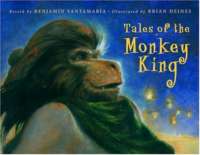
The first night I went to work at the shelter, the attendant said, “You know they will not rest.” I stood in the doorway of the dormitory crowded with children. In the dark, the nightmares would come, but rest would not. Empowering Mexico’s vulnerable street children is no easy task when the dangers they face are real and many. But there is incredible strength in an unfinished story, especially if that story has a small hero who can overcome great odds. Night after night, Tales of the Monkey King, begun at dark and never finished until the next day, were precisely what the children needed. The brave little monkey, who fought against unspeakable odds but was never conquered, had come from far away to become their hero. Through him, many found the strength and courage they needed to face their living nightmares and cheat the King of Death. Stunning paintings by Brian Deines underscore the message and speak to the hero in everyone.










